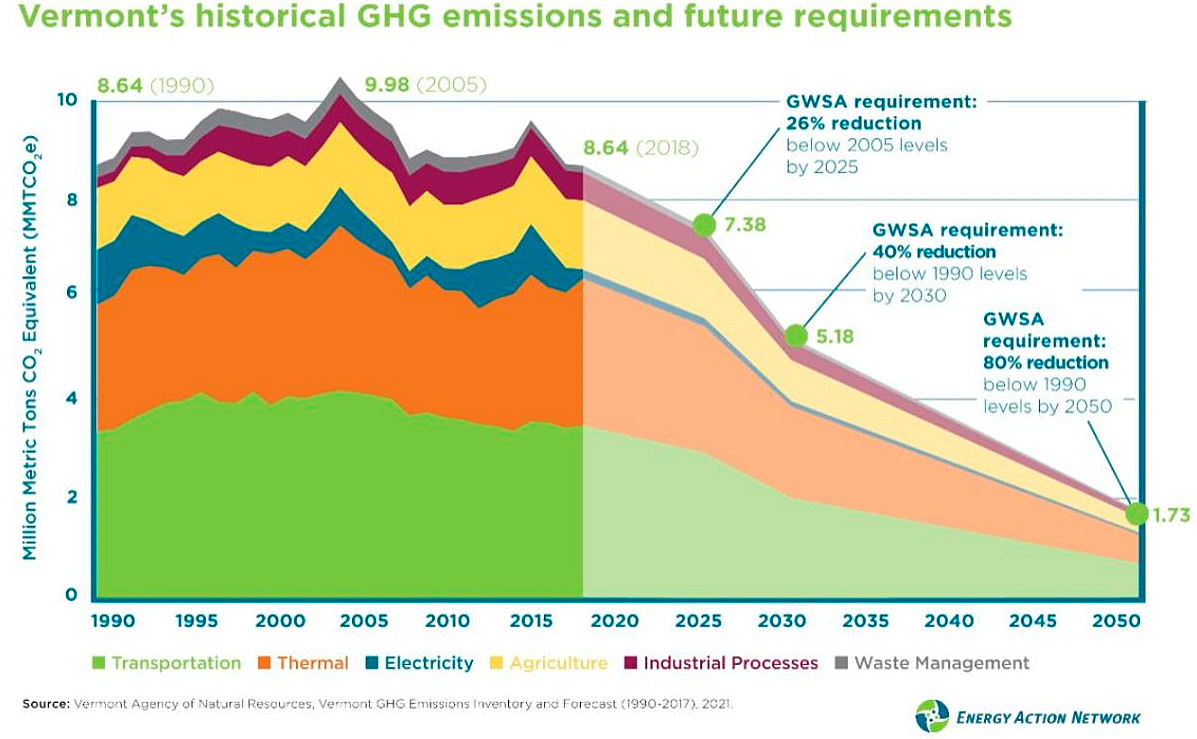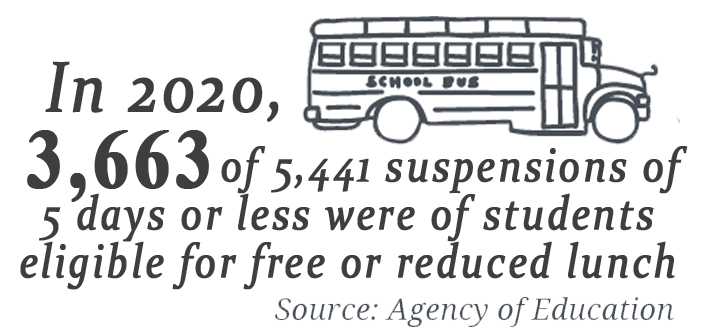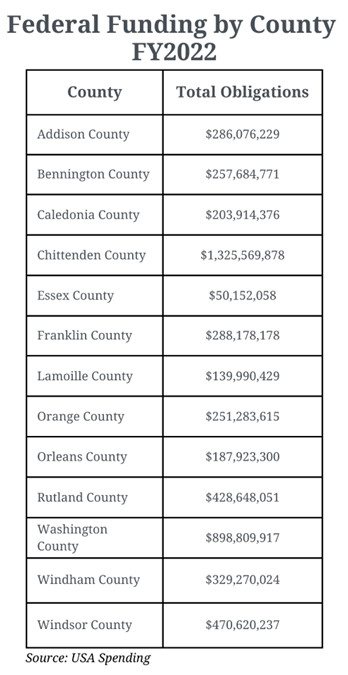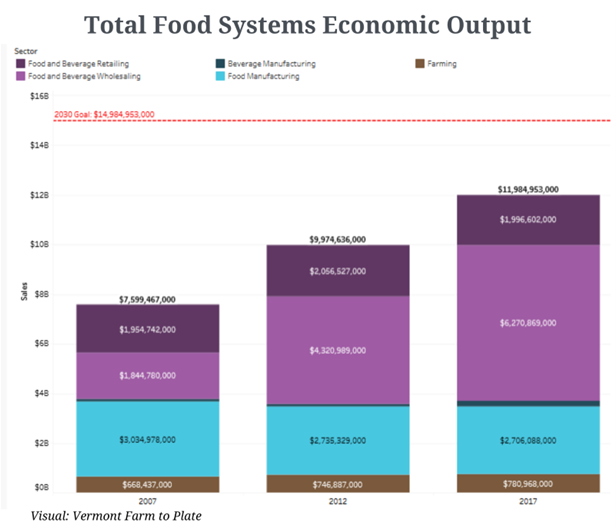2023 Proposition Scorecard
The Proposition Scorecard tracks data points tied to the goals of each of the ten Proposition elements. It does not interpret the data, instead provides context for data points that can be tracked over time, links to dashboards and data compiled by other organizations that are focused on work related to the Proposition elements, and includes “Progress/Future Action” where the Legislature, State government, and others have taken recent, relevant, and important actions. By consolidating this data, the Scorecard can highlight areas for celebration as well as areas where challenges require more attention.
Created with the support of the VT Futures Project, this Scorecard highlights the work of many organizations that are tracking quantifiable progress across the ten elements of the Proposition, and is drawn from public sources such as the U.S. Census and by recommendations from expert data stewards in the various fields related to Proposition elements.
#1 Broadband and Cell
Vermont must ensure affordable high-speed broadband and cellular access for all Vermonters, while using digital tools to promote community connection and democracy, and to advance local commerce and economic opportunity.
Through Act 71, the State of Vermont has invested more than $100 million in construction and pre-construction grants to improve Broadband access for Vermonters. The Department of Public Service (DPS) tracks the type of service Vermonters have access to, with a focus on an upload and download speed equal to 100/100 Mbps. See the DPS dashboard here. The most recent data available, from 11/8/2022, shows an increase in households with 100/100 Mbps access of 4 percent since 2021.
Progress/Future Action: As the broadband build out gains momentum, more detailed definitions and reporting on broadband affordability will be important in evaluating the benefits to communities. New broadband infrastructure is not the same as accessible or affordable broadband infrastructure. This challenge is a high priority for the Vermont Community Broadband Board and Communications Union Districts across the state, as well as organizations like Access to Broadband for Vermont.
According to the 2020 census, about 10.3 percent of Vermonters live in poverty. Further, using data compiled by the Vermont Housing and Finance Agency (VHFA), about 15 percent of Vermonters are “severely burdened” by housing costs. The total number of severely burdened households is shown at right by total number of households in each county, including both renters and homeowners. More information on the connection between housing and economic opportunity is compiled by VHFA at housingdata.org.
Progress/Future Action: Housing access and housing costs are an important driver of economic disparity in Vermont. Many households in Vermont are severely cost burdened by the cost of their rent or mortgage. In 2023, the Vermont Legislature set aside nearly $200 million in the coming fiscal year for new investment in housing construction, renovation, and other assistance as well as eliminated some barriers to housing construction in the state.
#2 Addressing Racism and Equity in Vermont
Vermont must combat racism, celebrate our diversity today, and welcome new Vermonters of color.
Home ownership has traditionally been an important pathway for wealth creation. The home-ownership data by Race and Ethnicity, presented here by the Vermont Futures Project, is based on 2010 census data and shows the small percentage of overall Black, Indigenous, and People of Color who own homes in Vermont. See the Vermont Futures project dashboard here.
Progress/Future Action: More and better information is needed about demographic changes as people move to and within Vermont, particularly related to the Black, Indigenous, and People of Color demographic. In 2022, the Vermont Legislature passed Act 182, which the creation of a Land Access and Opportunity Board "to recommend new opportunities and improve access to woodlands, farmland, and land and home ownership for Vermonters from historically marginalized or disadvantaged communities who continue to face barriers to land and home ownership." This Board is seeking ongoing funding from the Legislature.
#3 Climate Solutions
Vermont must advance creative solutions to climate change, as temperatures have risen about 3 degrees since the beginning of the 20th century and the growing season has increased by 3.7 days per decade.
Vermont’s greenhouse gas emissions decreased from 2005 to 2018, but will need to decrease significantly further to meet the State’s 2025 goals. In 2021, Vermont’s clean energy economy gained nearly 500 jobs after losing 1,400 positions in 2020 as the pandemic took a toll on the industry. More information on climate change mitigation work in Vermont, including the image to the right, is consolidated in the 2022 Annual Report of the Energy Action Network.
Information on the state of clean tech and green jobs in Vermont is tracked by the Department of Public Service in their 2022 Vermont Clean Energy Industry Report.
Progress/Future Action: In 2023, the Vermont Legislature passed the Affordable Heat Act, which calls for the creation of a system of tradeable clean heat credits. The rules that govern this system must be submitted to the Legislature by January 15, 2025. While the total cost imposed by this new system is debated, energy transition costs generally contribute to inflation but can also create opportunities for new business or innovation. The Scorecard will continue to track GHG emission goals as well as new economic opportunities in the form of green sector jobs.
#4 Economic Disparity
Vermont must reduce economic disparities, address poverty, and promote opportunities for prosperity for all Vermonters.
#5 Childcare
Vermont must ensure all children have access to affordable, quality childcare and education.
An acute shortage of available child care spaces places a significant cost burden on families trying to access childcare. In Vermont, according to the advocacy organization Lets Grow Kids, 60 percent of Vermont’s youngest children do not have the childcare resources they need. The actual costs of providing care are far higher than childcare providers can charge families, and as a result there are too few spots overall, and many of those childcare spots are unaffordable to many. More information about the current state of childcare in Vermont is available in the Let’s Grow Kids 2022 report.
Progress/Future Action: In 2023, the Vermont Legislature allocated significant new funds to the child care system, including more than $76 million in fiscal year 2024 and $125 million in FY’25. The Legislature’s action will also expand child care financial assistance to families making up to 575 percent of the federal poverty level and increase compensation, resources and professional training available for early childhood educators.
The Vermont Agency of Education has a data dashboard that provides information on many factors relevant to student success. Since 2018 when data is available, students who are eligible for free or reduced lunch at school have made up a significant proportion of suspensions of 5 days or less. More data about exclusionary discipline specifically is available here.
Progress/Future Action: As part of the follow up to the Proposition findings, the Future of Vermont Action Team has charged the Vermont Council on Rural Development with running a statewide engagement process to better understand Youth aspirations and opportunities for deeper connection to community. Initial findings of the engagement process will be available in December 2023.
#6 Education
Vermont must ensure that students of all backgrounds and abilities learn and thrive in public schools that advance diverse opportunities for educational, civic, and vocational success.
#7 Business and Entrepreneurship
Vermont must strengthen local business, entrepreneurship, investment, workforce and rural innovation.
The Vermont Futures Project tracks a number of metrics related to Entrepreneurship and Innovation in Vermont, available here. Vermont has a high 5-year survival rate for new firms, at 74.3 percent, but one of the lowest percentages of BIPOC-owned small businesses in the country.
Progress/Future Action: In 2022, the U.S. Small Business Administration and Vermont Professionals of Color joined a group of partners improving access to grants and services for BIPOC Vermonters. Understanding the patterns or barriers identified in this work is important to supporting future BIPOC small businesses in Vermont.
#8 Planning and Coordination
Vermont must advance efficiency and foresight through state planning and regional coordination.
Vermont has received significant Federal funding and is seeing more people move to the state and demand for housing grow. Towns without paid staff do not access Federal funds as easily. Supporting this basic capacity will help smaller communities prepare for the future.
Progress/Future Action: In 2023, the Legislature and Governor approved a $3 million allocation for small towns in Vermont to help them add capacity to apply for State and Federal funding they desire. This new arrangement could help increase the amount of funding flowing to towns without paid staff.
A functioning democracy requires sustained civic engagement. One way to measure this is through voter participation, but another way to think about this is participation on town boards, in community as coaches and mentors, and in support of local projects. Stepping forward for your community can make a significant impact—in 2022, more than $11 million was invested in towns that had undergone a VCRD process within the past 5 years, reflecting an availability of resources for people working to build a better future in their community.
Progress/Future Actioin: In 2021, the Vermont Legislature passed and the Governor approved expanded voting access, including establishing a vote by mail system. In 2022, 5.2 percent more voters participated in a statewide election than had participated in 2018, the last non-Presidential statewide election.
#9 Working Lands and Natural Resources
Vermont must conserve our lands and waters and advance our working landscape.
The Vermont Sustainable Jobs Fund’s Farm to Plate Network has created a dashboard that tracks total food system output, adaptive conservation practices, total local food purchases, and many other topics over time. That dashboard is available here.
Progress/Future Action: In 2023, the Vermont Legislature allocated $2 million to support the Working Lands Enterprise Initiative, a program that over the past 10 years has helped support 418 projects across Vermont, create over 500 new jobs and generate more than $55 million in new economic activity.
#10 Civic Engagement
Vermonters must renew civic engagement and strengthen trust, civility, community connection, democratic decision-making, and empower new leaders.












